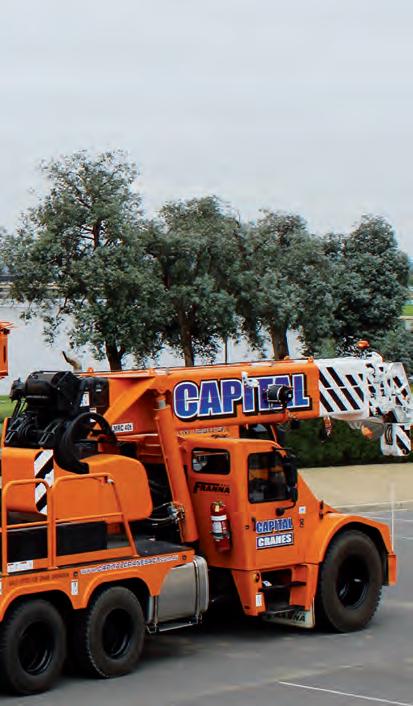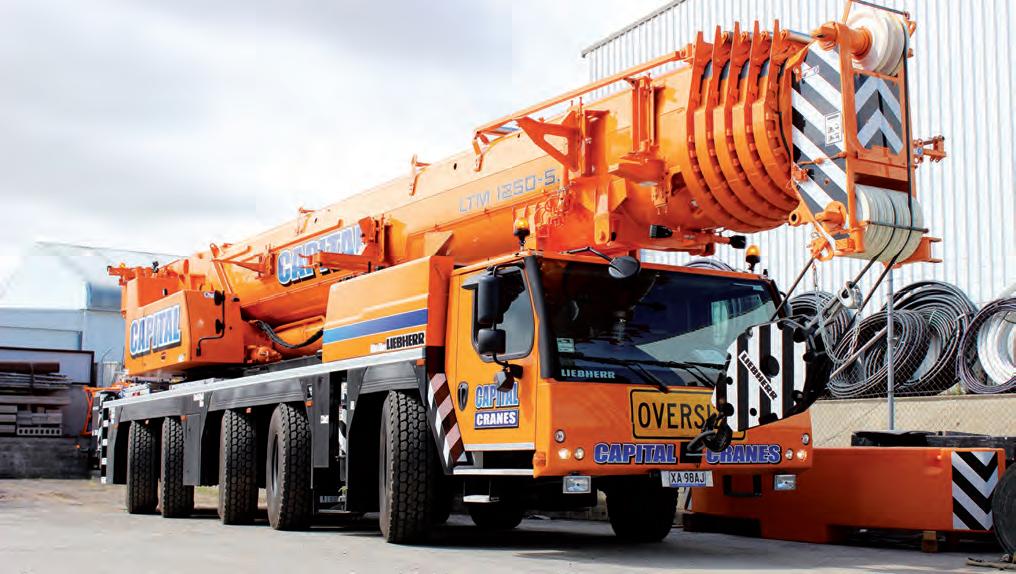
9 minute read
Investing in our capital
INVESTING IN CANBERRA, OUR CAPITAL
Capital Cranes recently took delivery of a new Liebherr LTM 1250-5.1. It is a significant risk and investment by owner Digger Misner and he discusses his reasoning for the purchase and how he expects it to expand the services provided by his business.
DURING THE FIRST ROUND OF COVID
lockdowns, in early 2020, Misner was forced to work from home due to social distancing requirements. He spent time reflecting on his business and examining what machines could help Capital Cranes keep a few steps ahead of the competition.
“It gave me time to reflect over 30 years of the business and back to the very first crane I owned, which was an International C Series 1800 backender pick and carry,” he explained.
“It featured a turbocharged Perkins motor and had a 6t lifting capacity. You knew when you were over capacity when the front tyres lifted off the ground.
“I also thought about the 20 or so cranes we’ve bought and sold over this time, including the Liebherr LTM 11305.1, which we purchased two years ago. It has been an excellent performer for our business but the population of this class of crane has been steadily increasing and they are now a fairly common machine
Digger Misner with the new Liebherr LTM 1250-5.1 and the Franna AT40. sight in crane yards.
“As I thought about the business, I knew I had to do something different to keep my competitive edge and I knew we needed a crane that would service the future demands of my customers. In my mind, the Liebherr LTM 1250-5.1 was the answer.
“One of the many struggles for a crane business is the threat posed when your customer goes to another crane business, because you don’t have a large enough capacity crane to handle a particular lift. The new crane 250t helps address this scenario.
“With 60m of main boom, the Liebherr LTM 1250-5.1 is the strongest mobile allterrain crane on five axles, it’s as simple as that. The Liebherr engineering team has done an incredible job in getting the same capacity from a previous six-axle carrier to a five-axle crane, and because it is on five axles it has a smaller footprint.
“Its ability to get on site and work in tight tolerances is outstanding. Liebherr mobile cranes are the most innovative mobile crane designed and manufactured and we will continue to invest in the brand because they are the best on the market,” said Misner.
With 12t axle weights, the crane is able to travel in the ACT with the boom in the cradle, but Capital Cranes also works in New South Wales, where there are lower weight limits per axle. The National Heavy Vehicle Regulator (NHVR) has placed travel restrictions on various bridges around borders, which means cranes have to travel with the boom in a dolly.
The crane has 88t of counterweight, which means there are four support trailers. So, logistically, it is a big step up for the organisation. But there is a growing market for these bigger cranes and Misner explained what he is seeing and what projects are in the pipeline.
“The federal and local governments are constantly telling us about the huge investment in infrastructure and that this sector is helping to drive the economic

recovery, post-COVID. The 250t is in readiness for this pipeline of work. If the works start in the next six to 12 months, Capital Cranes is going to be well positioned.
“You don’t order and take delivery of these cranes overnight. You’ve got to plan at least a year to two years in advance. I am also hearing that delivery times from crane OEMs are starting to become an issue, with deliveries on some models blowing out to 2023/2024. That’s not going to help a project which needs a 250t capacity crane next week.
“With an investment like this, you are trying to anticipate what machines the market will require for their projects. When you are looking to grow your business and move into larger cranes, with greater capacities, you might take a hit in the short-term, but the inquiries will come when the market learns you have larger capacity machines.
“There is a nervous period when the outgoings on new cranes are far greater than the income it is generating. Only when work is secured for the crane and it starts to generate revenue can you sit back and say it has been a good investment. That’s my experience anyway, and I dare say it is the same for many crane owners.
“I expect the 250t to work in general lifting and I know it will complement the 130t nicely. It gives us so many more options in terms of capacity. We now have the largest capacity Liebherr crane located in the ACT. I remind our Canberra and ACT clients that Capital Cranes is an ACT business, we are registered in the ACT, our cranes are registered in the ACT, and we pay our taxes to the ACT government. Let’s keep the business local.”
COVID delayed the delivery of the Liebherr LTM 1250-5.1, which only heightened Misner’s levels of anticipation and expectation.
“When you have worked so hard to build a business with the right team around you, it is hard not to get excited about a milestone event like taking delivery of this new 250t,” he said.
“The delays only heightened my already high levels of excitement and those of our team, and even our customers. At Capital, we are fortunate to have very loyal customers, so being able to supply the right crane to meet their project requirements is very important to us.
“I gave the purchase of the crane a lot of thought but most of my business decisions have been made on gut feelings. Unpredictable conditions such as COVID-19 and record rainfall, which affect revenue, are beyond my control, but interest rates were low when I purchased it, and this was a key factor.
“250t capacity cranes used to be large machines, but today, they are smaller, stronger and more versatile, and I can charge it out at lower capacities. In NSW,

Digger Misner’s first crane – an International C Series 1800 backender pick and carry.
I can travel the same roads as two-axle or three-axled cranes, with the dolly, so this will make a difference to the work we can do. We purchased a dolly with the crane and with this we can get it almost everywhere.”
Misner talked about the features and benefits of the Liebherr LTM 1250-5.1 and why he loves the Liebherr brand.
“This crane has the VarioBase option, which is unique to Liebherr machines. It has a single engine, which makes it more economical on fuel, and this reduces the associated maintenance costs because you only need to service one engine. The EcoMode ensures the machine is more environmentally friendly by reducing emissions.
“When the crane isn’t in use, it has an automatic disconnection from the drive, which means the engine isn’t under load all the time. I also bought the variable boom systems, which provide numerous options to boom and jib combinations. The crane can reach just under 100m and can lift up to 108m hook height. I also chose the second winch option and concrete panel fly, for precast concrete projects.”
Liebherr designers had a clear concept to follow in the development of this crane – to get the maximum lifting capacity from a five-axle mobile crane. Liebherr says that the LTM 1250-5.1 is now the most powerful crane on five axles in the world.
VarioBallast enables it to deliver maximum lifting capacities with a variable
Capital Cranes’ new Liebherr LTM 1250-5.1.
ballast radius, making it perfect for use on constricted sites with a small ballast radius. And it achieves this by quickly adjusting the ballast in seconds.
The crane can be fitted with a multifunctional folding jib, a long lowering fixed jib or a rigid powerful jib. VarioBase, ECOmode and ECOdrive technologies make the LTM 1250-5.1 particularly safe and efficient, it adds. It also has increased safety and flexibility by having lifting load charts with different operating maximum wind speeds.
“Capital Cranes is focused on environmental responsibility and sustainability is a priority for us,” said Misner.
“The new 250t ticks a number of these boxes. Liebherr is also at the forefront of eco fuels developments, and we will adopt these new technologies as they arrive.”
The 250t is ideal for the expected infrastructure boom, including the major bridge replacement program planned for regions of NSW surrounding the ACT. The crane is ideal for large infrastructure projects, including bridge building. It is also an ideal support crane for the energy sector, especially renewables, including wind farming, and it is tailor-made for the construction of electrical distribution infrastructure projects which are in the pipeline, said Misner. He went on to explain the reasons behind a second new crane purchase: a Franna AT40.
“The new Terex AT40 Franna was not necessarily on my list of cranes to buy,” he said.
“Being a new capacity crane, I wanted to be sure it was going to be reliable and that Franna had ironed out any little gremlins in the machine. I wanted to see a proven track record before I invested in the crane, and I couldn’t really see a market that my 25t Franna couldn’t service. Why did I purchase the AT40? For the same reasons as the 250t. I wanted to keep my competitive edge and create markets for its extra capacity.
“Now, slowly, our customers can see the benefits and we are finding increasing uses for it. Our operators have found it to be a great lifter and smooth to operate. There are a number of great features in the AT40, which I hope find their way into the smaller-capacity Frannas.
“We had some technical issues with the crane, and this wasn’t helped with Franna technicians not able to travel across the border due to the lockdowns. But, as soon as they were able to get here, they fixed everything and took notes, which shows they are looking to improve the product all the time.”
The LTM 1250-5.1 and Terex AT40 will help Capital Cranes to maintain its competitive advantage in the long run, said Misner. He is also looking at his business with renewed vigour and a sense of purpose, brought on by the lifting of the COVID restrictions and the arrival of the new cranes.
“Since borders have opened and restrictions have been eased, there is a real sense of positivity,” he said.
“I am now able to discuss projects with engineers who are keen to see bigger and heavier lifts, and fewer of them. This is the way the construction sector is going. In 2021, this crane might be seen as a large crane, but in the future, it will probably be a common sight in yards, like the 130t is today.
“A big part of this purchase is my investment in the business, and I don’t just mean monetary. I enjoy the business of cranes. I have a great team and they take pride in the business and our cranes. I enjoy the social interaction of meeting with customers and discussing projects; I missed this during the lockdowns.
“The new cranes have renewed my vigour for the business, I feel I have plenty to offer the industry and I am ready for the next stage in the evolution of Capital Cranes.”











